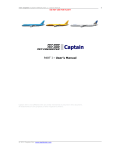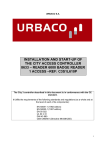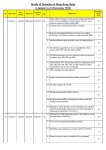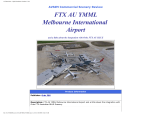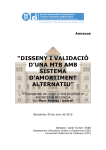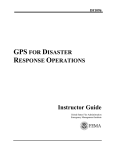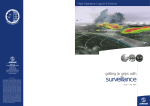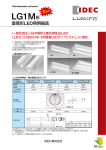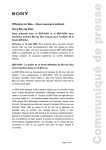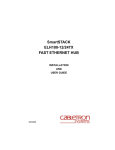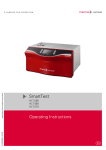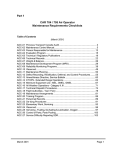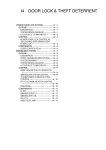Download Captain Sim 757 Pro Pack
Transcript
AVSIM Online - Flight Simulation's Number 1 Site! AVSIM Commercial Aircraft Package Review Captain Sim Boeing 757 Pro Pack Product Information Publisher: Captain Sim Description: Boeing 757 Pro Pack. Download Size: (FS9 / FSX) 112 MB / 110 MB 33.5 MB / 13.8 MB 21.7 MB / 9.9 MB Format: Download 757-200 (FS9/FSX) 757-300 (FS9/FSX) 757 Freighter (FS9/FSX) Simulation Type: FS9 - Version 2.0 FSX - Version 4.1 Reviewed by: Angelique van Campen AVSIM Staff Reviewer - September 22, 2008 file:///E|/AVSIM/Reviews/CS%20757/CS757.htm (1 of 19)23/09/2008 7:03:31 PM AVSIM Online - Flight Simulation's Number 1 Site! Introduction Not that long ago, I wrote a review of the Just Flight/PSS Boeing 757 model, so I’m a little more than familiar with this typical aircraft. Why typical? The Cockpit looks very similar to its big brother, the 767-200/300, while the fuselage is much thinner or to be exact, the same fuselage diameter from the much older 727 and its smaller sister, the 737 Series. That’s why it’s a strange looking bird, but nonetheless, Captain Sim produced a great product with this Pro Pack FS9/FSX version. Since it’s now a full competitor - with the integration of a fully operative FMS - of the previously mentioned Just Flight 757, but it also competes with models like the Level-D 767 Series, PMDG 747-400, Flight1 ATR 72 etc. Ok, let’s first have a look on the Captain Sim website and see how they promote the 757-200 Pro Pack with the additional 757-300 and freighter packages: Exterior: • Highly detailed and accurate Models: Boeing 757-200 - 12 models, Boeing 757-300 - 12 models and the Boeing 757 Freighter - 9 models • High resolution textures of 46 Liveries • From 97 to 142 custom Animations including animation Control Panel • 2 animated cargo Loaders (all models) and 30 animated cargo Containers with 2 Load Manager Control Panels (freighter version) • Stewardess model (various airline uniforms) • Dynamic Wing Flex, Wing Flaps Vortices and blended Winglets Just to give you an idea of Captain Sims own screenshots and how they see their own Boeing 757 Pro Pack! Pretty impressive, isn’t it? I know too many pictures of the onboard lavatory but I needed so urgently, that while sitting here, I could make some pictures for you. It also gave me the feeling I was sitting in a real toilet … oops … virtual FS9 toilet. Interior: • Highly detailed VC including: Flight Deck, passenger cabin, galley and lavatory, lower and upper Cargo Deck (Freighter version) • 273 custom 3D Animations and high resolution Textures Systems: • Extensive Systems Programming, Flight Management System (FMS) • 2 high resolution full-screen 2D Panels and 6 High resolution full-screen 2D Interior Views • 40+ additional 2D Panels and 2 Passenger Wing Views Misc Features: file:///E|/AVSIM/Reviews/CS%20757/CS757.htm (2 of 19)23/09/2008 7:03:31 PM AVSIM Online - Flight Simulation's Number 1 Site! • ACE (Aircraft Configuration Editor), authentic Sound Set (PW and RR engines) and realistic Flight Model • Exclusive visual effects, repaint Kit with 119 free liveries and an extensive Manual in 5 parts Free Bonus Features: • Collins WXR-2100 Weather Radar and aeronautical data And believe me, this is just a small extraction of the much longer list on the Internet. That’s not all, the screenshots provided by Captain Sim gives you the idea you’re looking at a real aircraft and sometimes it’s hard to see if it’s fake, real or modeled for Flight Simulator. It’s my challenge to work this out, look into and outside of the model and see if it really is worth the money and its reputation, which we know from the Legendary 727 and the Boeing 707 Series. A brief description of the Boeing 757 The 757 is a twin-engine, new technology jet airplane designed for low fuel burn and short-tomedium range operations. This airplane uses new aerodynamics, materials, structures, and systems to fill market requirements that cannot be efficiently provided by existing equipment or derivatives. The 757 is a low-noise airplane powered by Rolls-Royce RB211-535C, -535E4, or -535E4B, or the Pratt & Whitney PW2037, PW2040, or PW2043 engines. These are high-bypass-ratio engines which are efficient, reliable, and easy to maintain. During the 1970's, Boeing derived several proposals for a successor to the three-engine Boeing 727 aircraft, which typically seated between 94 and 189 passengers, and was a very successful aircraft particularly in US domestic markets. The final design of the 757 was decided upon in the late 1970's utilizing the same cabin crosssection as the 727/737 but with a considerably longer fuselage, a redesigned wing and modern high-bypass fuel efficient turbofan engines. Boeing also designed a state-of-the-art advanced two-crew flight deck with Electronic Flight Instrument System (EFIS). This incorporated six cathode-ray tube (CRT) displays housing primary attitude data, navigation display and engine parameters, including an automated crew alerting system (a system of messages and aural warnings which presents the crew with information on the extent or significance of non-normal situations). Another feature of the aircraft design was commonality with the Boeing 767, which was developed alongside the 757. The two aircraft types share a number of systems, and the flight deck is almost identical allowing a common pilot type-rating between the two aircraft. Let’s have a look to the different models/types. 757-200 The 757-200 family of airplanes consists of passenger and package freighter versions. The passenger version is available in two configurations: • The basic configuration (overwing-exit) has three LH and RH passenger doors and two LH and RH overwing exit doors. • An optional configuration (four-door) has the same three LH and RH passenger doors but with LH and RH exit door aft of the wing, in lieu of the overwing exit doors. In the passenger configuration, the 757-200 can typically carry 186 passengers in a six-abreast, mixed class configuration over a 2,900-nautical-mile range with full load. High gross options can increase the range to about 3,900 nautical miles. High-density seating arrangements can accommodate as many as 239 passengers in an all-economy configuration. The 757-200 can be equipped for Extended Range Operations (EROPS) to allow extended over water operations. Changes include a backup hydraulic motor-generator set and an auxiliary fan for equipment cooling. 757-200PF The Package Freighter (757-200PF) airplane is designed to carry an all-cargo payload. Maindeck cargo is either in cargo containers or pallets and are loaded through a large cargo door file:///E|/AVSIM/Reviews/CS%20757/CS757.htm (3 of 19)23/09/2008 7:03:31 PM AVSIM Online - Flight Simulation's Number 1 Site! forward of left wing. The -200PF has no windows or passenger doors in the fuselage. A crew entry door is provided forward of the main deck cargo door. 757-300 The 757-300 is a second-generation derivative of the 757-200 airplane. Two body extensions are added to the airplane fuselage to provide additional seating and cargo capacity. The 757300 can typically seat 243 passengers in a dual-class arrangement or 279 passengers in an alleconomy configuration. The EROPS (Extended Range OPerationS) option has been incorporated in the 757-300. Installation, documentation and additional info Installation (FS9/FSX) Apart from the “Instant Online Activation”, it’s all straightforward without any problems. Oh, I forgot to mention that you need to enter your “order number” but that’s all. By the way, the online activation works perfectly. I don’t mean to say it never goes wrong, but I had no problems when I did it. The first package you need to install is the “757-200 Pro Pack”. The 757-200 comes with all that you need to fly this aircraft, including a fully operative FMS, IRS, passenger cabin and lavatory view and the real engine sounds of the RR (Rolls Royce) and PW (Pratt & Whitney) engines. By the way, during the installation/initialization process you don’t need to check the FS9 location, since it’s taken directly from the Windows Registry, so no problems here. After this, it’s all up to the installer and before you know it, you’re finished. In my case, I needed to perform two additional installations for the 757-300 package as well as the freighter version, but those installers work in the same way. First of all, the 757-200 Pro Pack Online or Offline Activation possibility Remember your order number! Automatic FS9 directory detection Next installation: Boeing 757300 Series Last install: the Boeing 757200 freighter version It should give you some idea of the installer(s). The only part which needs some attention is if you chose for the online or offline activation and you need the order number. That’s all and then you’re saddled. Click the OK button and before you know, you’re done. These screenshots are FS9 related, but the same will be seen when installing the CS 757 packs under FSX. What else is important after the installation process (es)? Via the Start menu button you find under All Programs -> Captain Sim -> 757 Captain, lots of things: file:///E|/AVSIM/Reviews/CS%20757/CS757.htm (4 of 19)23/09/2008 7:03:31 PM AVSIM Online - Flight Simulation's Number 1 Site! - Uninstallers for the 757-200 and in my case for the 757-300 and the Freighter, - ACE program (Aircraft Configuration Editor), - Web browser link “Manuals, Support, Updates, Free liveries, Repaint Kit and more…”. To save space or to reduce the downloaded files, the manuals and other stuff must be downloaded separately. Personally, I found it was a better idea to add the manuals into the installers, but on the other hand downloading them from the CS website gives you the latest versions. The basic installers come with so many liveries and if the arsenal of Captain Sim liveries is not enough for you, just do a search in the AVSIM library and dozens of liveries will be available. That’s it, nothing more and by the way, the ACE (Aircraft Configuration Editor) will be separately discussed. Documentation Let’s see what Captain Sim offers to make you a professional virtual 757 captain or co-pilot; - Part I “User’s manual” (cs757_manual1.pdf), According to Captain Sim, this user’s manual describes the 757 product as a software title. That means every Pro package is discussed separately with lots of pictures to support the text. Very important and related to the 2D cockpit is the discussion of the Icons Control Panel, for FS9 and FSX. Thus the manual is applicable for both MSFS versions. In other words, a nice read and highly educational manual. - Part II “Aircraft Systems” (cs757_manual2.pdf), It’s not the same as the 757 POH (Pilot’s Operating Handbook) from the Boeing Company, but for the beginner, intermediate and expert user it offers lots of detailed descriptions and operation of almost every aircraft system; ranging from aircraft and avionic systems as well as the Auto Flight parts. This, together with the panel pictures, makes it all well understandable and readable. - Part III “Normal Procedures” (cs757_manual3.pdf), 36 pages full of procedures, operating limitations, checklists and flight patterns. - Part IV “Flight Characteristics and Performance Data” (cs757_manual4.pdf / not yet available), - Part V “Flight Management System” (cs757_manual5.pdf). Time to study since this comprehensive 91 pages FMS (Flight Management System) manual explains every detail of how to handle the CDU (Control Display Unit), program flight information and much more. What I miss is a flight tutorial that guides the user through all the steps needed to make a successful flight. Is it a problem? Not really, but as I said before, a complicated aircraft like this could give problems for beginners. Immediately the question rises if this aircraft is applicable for beginners? Of course it is, but the beginner needs a lot of study via the offered manuals to learn how to handle and fly this aircraft. There’s no reason to offer you several screenshots from the CS manuals. Some pages have pictures, but I think that will give a clear view of the real contents. What I can say after sifting through all the manuals, is that they are all in-depth, didactically organized and there’s a good balance between pictures and associated text. As I already mentioned, unfortunately there’s no tutorial flight and although I don’t miss it, I could imagine some users who want to fly this 757, running into problems. Then there’s something else which is worth mentioning, there are a bunch of instruction/ promotion video films available on the CS website. You can find several videos with lots of background information or how to do things. Are those movies only applicable for beginners, intermediate or expert users? That’s up to everybody’s background knowledge as well as the interest to learn something more then just looking at/reading the books. You’ll find movies explaining the EADI (Electronic Attitude Direction Indicator) and EICAS (Engine Indication and Crew Alerting system) displays or the EHSI (Electronic Horizontal Situation Indicator) display. What about gear extension and retraction, pilot seat control and many other items? I want to warn the expert users. Don’t expect highly complicated movies, but I think that in combination with the manuals, it gives it all a huge plus. Conclusion, good work CS! file:///E|/AVSIM/Reviews/CS%20757/CS757.htm (5 of 19)23/09/2008 7:03:31 PM AVSIM Online - Flight Simulation's Number 1 Site! Some background … ACE (Aircraft Configuration Editor for FS9/FSX) It’s not yet time to start with the cockpit impression. No, it's time to explain something of the CS tool, known as ACE (Aircraft Configuration Editor). Is it a complicated tool? No, but it is worth mentioning and highlighting certain parts. By looking at the screenshots below, you can see that the tool is divided into three tabs; FLEET, PREFLIGHT and TOOLS. Let’s have a closer look to the individual tabs. FLEET EXISTING tab – Shows installed aircraft liveries FLEET ADD NEW tab – Installation of a new livery FLEET ADD NEW tab – FLEET ADD NEW tab – Allows Selected a new livery but not you to add/install new liveries yet installed PREFLIGHT tab – Passenger Load Editor (there’s no fuel planner) TOOLS tab – Verifying the MSFS- and Flight Files path A very handy and easy to use tool for adding new liveries (aircraft textures), modifying passenger loads and verifying installed path. The only thing that’s missing is a fuel planner. According to CS, the user needs – unfortunately - to use the default MSFS fuel planner. Under the FLEET tab you’re able to modify on the fly – FS9 or FSX should not be active – the available basic CS liveries. On the fly means you’re able to add/remove winglets, activate or deactivate the VC (Virtual Cockpit) and select between either a cabin or wing view. These changes are possible for every RR/PW equipped 757, so for the -200, -300 and freighter aircraft. At the same time, this FLEET tab can also be used for adding new liveries/textures. See this option as being similar to the well known one from Flight1 - the “Text-O-Matic”, although it’s not that complicated to handle. Since part I of the manual explains in detail how to add new liveries, there’s no need for me to explain it here. Let’s continue to the next tab, PREFLIGHT. The PREFLIGHT tab is no more than a well developed and user friendly passenger/cargo loader for either 757 aircraft. It’s very flexible; you can enter individual passengers or individual cargo containers, which can be loaded separately with a lower deck cargo loader or – for the freighter version – upper deck cargo loader including full animation, but that’s for later. Loading can be done in KG (kilograms) or LBS (pounds). To make it clear, this ACE tab doesn’t offer a fuel planner and for this the default MSFS planner should be used or another external add-on planner! This disappoints me, to be honest, since with so many things available, this essential part is missing. The last tab, TOOLS, offers not that much. It’s more related to troubleshooting and to be exact, corrects the Windows path for the MSFS directory and flight files. Whenever there’s a need to change it, you can do this here. It also offers you a button to test your Captain Sim 757, but that’s only useful when requested by the Captain Sim support officer. file:///E|/AVSIM/Reviews/CS%20757/CS757.htm (6 of 19)23/09/2008 7:03:31 PM AVSIM Online - Flight Simulation's Number 1 Site! External and internal aircraft model There are many reasons to start with the external view …. Why ….. It's Awesome! I can’t find any other words for expressing myself. This is really the first MSFS model I’ve ever seen creating an external model which reflects, within the boundaries of MSFS, an almost perfect model. “Almost perfect” sounds like it’s not perfect! No, that’s not the intention. Almost means, in this case, it’s more or less perfect, but it can never be the same as a real one. Ok, let’s put it this way; the external model reflects a real 757 about 99%. Also for CS there are MSFS limitations like the maximum polygons. On the other hand, it seems CS doesn’t have any problems with all of this. How they have done it? Don’t ask me and that’s probably a secret of the CS developers. What makes this CS 757 Series so much different than all the other MSFS aircraft or competitive 757’s? Oops, that will be a long list! It'is not only those tiny details, which are available on CS models, it’s also the painting and above all, the aircraft maintenance state in which you can configure this aircraft. Via a handy floating menu, you’re able to change so many things. Ok, it’s time to have a quick look at some aircraft maintenance configurations and at the same time, reflect on the highly detailed model. Via the tool (RH lower corner) opened the radar, LH FWD PAX door and wheel blocks Used the same tool to control the UPPER deck cargo door, opened the LH engine cowlings and installed the engine covers Tools controls the AFT Cargo door, MAIN WHEEL WELL doors and extended the RAT (Ram Air Turbine) Close-up pictures of the main gears, main wheel well doors and the excellent RAT presentation Very nice digitalized photo’s from the engine plastic covers including open cowlings with even detailed engine parts. A close-up of the main deck cargo compartment including – via the opened passenger door – the yellow crash net. Convinced? I was and I still am. So many things are simulated to bring this 757 in a maintenance state configuration. The only problem, is every flight simmer interested in all those funny things? I don’t know, but what I do know is that the rest of the model is still of that high quality. This is just a part of the total high quality model. In this case, it doesn’t make any difference for me. You like it, great. You don’t like it, no problem since many other items are of the same quality. Conclusion, for every flight simmer there’s something that he/she likes to look at. Most important, it doesn’t result in a lower quality cockpit or simulated systems. Before we go into the interior of a freighter model, here some close-up pictures taken with the help of Walk & Follow and again, all those tiny details are perfectly in place. file:///E|/AVSIM/Reviews/CS%20757/CS757.htm (7 of 19)23/09/2008 7:03:31 PM AVSIM Online - Flight Simulation's Number 1 Site! Very detailed Nose Landing Gear. Even the RR engine looks great. Leading and Trailing Edge flaps are well simulated and every detail is there. I think it's time to wash this airplane, it looks so dirty! Apart of the detailed fuselage, look at the inside door lining. With the FLAPS fully extended it's really time to start the washing. Some screenshots of the external model with the help of Walk & Follow. I took the Iberia 757200 RR, but I could have taken any other company or model. To be honest, it doesn’t matter. All the external models look very realistic, eye for details and … how did they do it? Ok, this concludes the external model. During our flight test, we will see some more screenshots, but this should be more than enough and it should not be a slide show review. I can tell you, and I think many others who own already the CS 757 blocks will agree, that these pictures represent all the other external models including all the details. All the above is related to the FS9 model, but for FSX it’s a little different. It goes even much further. Unlike with others, this FSX version 4.1 of Captain Sim's 757 is completely redesigned from scratch to use all the advantages and benefits of FSX. Due to my computer specifications and graphics adapter, which doesn’t support DirectX 10, I’m not able to check all those things but what I’ve seen with FSX, I’m already very pleased regarding the external FSX model. Now it’s time to have a look into a cabin and to be more precise, the main deck cargo compartment including the two lower cargo holds. No pictures from a passenger compartment with the business and economy class or galley and lavatories. No, nothing of this! The reason to shoot only freighter interior pictures is because it reflects the quality in general and is also applicable for any CS passenger aircraft. Then, of course, too many pictures are also not a good idea and last but not least, the CS website offers great passenger compartment pictures. The interior of the CS UPS 757-200 is very realistic. I’ve never seen inside the real interior of a 757 freighter, but I’ve seen many other freighter or combi airplanes like the Airbus A300B4, A310-200 (Martinair Holland), DC-10-30 and even the Boeing 747-400. That’s one of the advantages of freighters; the interior walls, floor panels and ceiling linings of a main deck cargo compartment are, in general, all the same and CS used many digitalized photographs to simulate this and to create a real looking compartment. I can tell you, the screenshots really reflect this. The only thing that’s missing is the compartment smell. Smell … yes … pallets full with dirt or old used containers or residue from animals etc. Of course, the smell is just a joke and can’t be simulated, but I hope it convinces you in combination with the pictures below, that it’s very well done. Here we go, via the cockpit we crawl through the crash net into the compartment. file:///E|/AVSIM/Reviews/CS%20757/CS757.htm (8 of 19)23/09/2008 7:03:31 PM AVSIM Online - Flight Simulation's Number 1 Site! You can take a rest before the crash net next of the door. Upper Deck Cargo Door is open with the hi-loader in position. Empty hi-loader, but containers and/or pallets are coming. FWD Cargo Hold with stair to the cockpit compartment. Just a screenshot from a different angle in the FWD Cargo Hold. It’s a little dark in the AFT Cargo Hold but with an open door…. A typical view of the upper main deck cargo compartment while the three lower screenshots are the lower cargo holds. Nothing is painted by hand, all are digitalized images and that makes it so realistic. Even the small stair in the FWD lower cargo compartment is created, the ball mats are there and many other small details. Although it's not the passenger compartment, it still offers the load masters some realistic looking seats, the crash net looks very familiar to me as well. CS has done a great job! Available cockpits Virtual Cockpit (FS9/FSX) Normally I start with the 2D cockpit, but this time there’s a very good reason to start with the virtual representation of this highly realistic looking VC. How realistic is it in relation to the real 757 cockpit or flight deck? Let’s have a look and take three real random Airliners.Net cockpit pictures and see what CS offers. I can tell you, it will be very difficult since the CS VC – oops, Captain Sim Virtual Cockpit – is based on digitalized photo images. Enough of this. It’s now time to see and judge for yourself about the VC quality of the CS VC. The overall view of the cockpit is very good and highly realistic, but even close-up shots are still impressive. Indicators are still sharp and so realistic that you hardly believe it’s a MSFS simulated model. Text or placards on panels are readable, even if I put my nose and eyes almost against a panel. It’s really incredible. I’ve never seen this before. At the same time, I do see on-ground or inflight FPS (Frames Per Second) drops, but that’s not too much. Ok, when my FPS slider is set to unlimited, with a Aerosoft or FlyTampa airport scenery installed, the VC offers me between 20-30 FPS and that's during daylight flights with building storms selected. In other words, not bad at all and that for a very detailed cockpit like this one. Ok, let’s compare the CS VC with a real cockpit. file:///E|/AVSIM/Reviews/CS%20757/CS757.htm (9 of 19)23/09/2008 7:03:31 PM AVSIM Online - Flight Simulation's Number 1 Site! Courtesy of Airliners.Net The three pictures on the top versus the ones on the bottom are taken more or less under the same angle and lighting conditions. Since Captain Sim uses digitalized images, it’s not that easy to see the differences between a real and fake virtual cockpit although good looking helps …! Courtesy of Captain Sim Pretty impressive isn’t it! I got you! Three screenshots on the top are the ones from Captain Sim 757, while the three below are from a real Boeing 757 cockpit. Probably you had your doubts but now you know you can see it. I’m impressed about the overall VC look of Captain Sim’s cockpit. By the way, these days you see more and more that developers are using digitalized images to create a VC. A good example is the recently released CLS 747 Classic, where the VC is made by Jacob Kubique Julius. This was the first set of Virtual Cockpit pictures, but more is coming. Making more and more screenshots is not really needed, since Captain Sim's website offers many pictures. What the website is not offering are close-up ones and then - as already written before - you will be impressed with the sharpness of instruments, the indications, text, placards and many other things. Using photorealistic digitalized images lifts the VC to a much higher level and finally to a great looking cockpit. If you fly from the VC or the normal 2D cockpit, that’s up to you and the frame rate impact. On the other hand, if you own the TrackIR from NaturalPoint, it’s fun and by fun I mean, real fun! Due to the awesome graphical presentation of the whole cockpit, you get the impression you’re sitting in a real cockpit! Looking into every corner and checking almost every switch, I’m very pleased to say that many systems are simulated and not only the Auto Flight and Navigation Systems. s known from the Level-D 767 where almost every switch is working/simulated, it seems that this is also the case with this CS 757. From my own experience and listened to gauge developers; FS9 and even FSX are not that advanced that aircraft systems can all be simulated like the real ones. There are limitations in MSFS, but it looks nice when everything can be selected or seems to be working. The only thing I found is a non simulated/missing RAIN REPELLANT pushbutton, located on the lower mid overhead panel. I looked around on Airliners.Net and most airliners still have the pushbuttons, but with INOPERATIVE placards. I know, not a very important missing item and probably only the experienced CS 757 users know this or they have even found other things I haven’t seen. Unfortunately, I need to modify my previous statement that everything is simulated. During the test flight preparations I found out that the IRS is not simulated as I hoped. It seems when you select the three IRS Mode Selectors to NAV, that within 20 to 30 seconds the L/C/R IRU’s file:///E|/AVSIM/Reviews/CS%20757/CS757.htm (10 of 19)23/09/2008 7:03:31 PM AVSIM Online - Flight Simulation's Number 1 Site! (Inertial Reference Units) are aligned to fully 100% (check with the help of actual PPOS Shift +Z). So not approximately 10 minutes, no need to enter any longitude/latitude position in either the FMS CDU or the IRS Control Panel. However, you can enter PPOS (Present POSition) via the CDU or IRS Control Panel, but I’m sorry to say, that’s fake. The simulation model will automatically enter it for you. Also the lights “ON DC” and “ALIGN” are not illuminated in the correct sequence when you set the switch to NAV mode. There’s something else what needs your attention. With a total electrically dead aircraft – no APU- or EXTERNAL POWER including switched OFF both the BAT and STBY POWER switch – the FMS CDU is powered and the OFF lights of the BAT and STBY POWER switch are illuminated. Where the power is coming from, I have no idea. Since I started getting worried about all of this, I uninstalled CS 757 from my Dell PC and reinstalled it, but without any success. Then I also installed it on my notebook, but guess what? No success. No success means, what is written above is unfortunately really a problem or at least, not reflecting the reality. Another remark; when you start the APU for example – toggle the APU START switch to START and then to ON – the FAULT light should illuminate momentarily. It indicates that the FUEL VALVE is opening (disagree light). CS Manual II is telling you this but the simulated model doesn’t show you this, so something is not correct. With some of these “snags” automatically the question comes … what else is not simulated or done incorrectly? I’m sorry I can’t check it all, but CS is the only one who can answer this. Whatever, the external aircraft model and the 2D/VC cockpits are all awesome, that you hardly expect that you aren’t able to enter - for example - IRS data. Last incoming Captain Sim notes regarding missing the RAIN REPELLANT pushbuttons, some light problems and the IRS: The panel was created using original aircraft photos. In other words, there were no pushbuttons at all, so we created the panel the same way. Regarding the previous mentioned “snags”; Captain Sim is busy with FS9 Service Pack 2.1, which should solve all those minor problems. That the IRS automatically aligns - noticed with FS9/FSX - without any actual PPOS (Present POSition) stays like it is. There are currently no plans to update this feature. Very realistic view of the copilots seat and side wall Captain out for coffee. BTW, look to the incredible details. file:///E|/AVSIM/Reviews/CS%20757/CS757.htm (11 of 19)23/09/2008 7:03:31 PM Very handy, 2D sub panels available within VC cockpit AVSIM Online - Flight Simulation's Number 1 Site! Is this real or simulated? Unbelievable detail Missing RAIN REPELLANT buttons, done on purpose? You may judge, but those screenshots represent a used virtual CS cockpit and not – for example – the one I did some while ago, the Boeing 757 from Just Flight/PSS. Immediately the following question rises; is this one better than the other or more realistic than the other? I don’t think so. Both have something unique. The JF/PSS one offers a cockpit/airplane just handed over to the customer where all the panels etc. are based on handmade painted design, while the CS 757 is almost entirely based on digitalized images, which offers the user a very realistic cockpit. Personally I like the CS 757 more but that’s purely my opinion and it has nothing to do with the better quality. No more Virtual Cockpit pictures? This is it … end! If I want, I could make movies to show you all the ins and outs of the CS VC, but I think with all the above VC pictures you have a very good idea of what to expect. Based on my real life personal cockpit experience, I will give this cockpit lay-out and realistic look a 95%. Not 100% or not 95.1% since there’s always something to improve on. 2D cockpit (FS9/FSX) Digitalized images, which were applicable for the VC screenshots, also apply to the 2D cockpit. The main cockpit panel and the many sub-panels are all digitalized pictures, which give you the idea that you’re sitting into a real cockpit. I have to admit, the panels sometimes look “used”, sometimes even ugly, but it’s the real look of panels after they've been used for months or years by pilots. It’s full of scratches, paint is missing due to … I don’t know. Even the panels have slightly different colors because once in a while, instrument panels are replaced with new ones and those repainted panels look new. That together gives it a very good overview. Since this is my first experience with a CS model, I need to say that CS put a lot of effort into the creation of sub panels, including cockpit side/back views. I will not show you all the different panels and photorealistic side views because that’s too much. A small collection of screenshots reflects all the other available panels or views and shows again the detailed and great look of the 2D setup. When I take the time to look at all those panels and compare them with the JF/PSS 757, I miss something, apart from if it’s really necessary. Necessary, I think so, since this MSFS model could – for example - trigger beginners who are not familiar with FMS. I mentioned earlier about the missing flight tutorial but adjusting/ manipulating the IRS align, is also not available. You can’t change the EADI look (speed tape EADI or non-speed tape version), like you could on the JF/PSS 757. Then, for example, the “Aircraft state at startup”; there’s no possibility here to do so like on the Level-D, you can’t save a special flight/aircraft configuration. I could continue the list with other things or tools which are missing on this CS 757, but is it all disappointing? Not at all, but it’s worth mentioning and warn the fresh new simmer that lots of tools are not there. That means, when you’re a beginner or a seasoned user and you don’t have any experience with highly sophisticated add-on aircraft, you need to read the manual. Ok, let’s go back to the 2D cockpit and before I continue, here’s a small collection of some screenshots. file:///E|/AVSIM/Reviews/CS%20757/CS757.htm (12 of 19)23/09/2008 7:03:31 PM AVSIM Online - Flight Simulation's Number 1 Site! Extreme enlarged Control Panel with main captains panel (FS9) DOORS and additional external components control panel (FS9) FSX Main Captains panel with enlarged FSX Icons Control panel, which is slightly different then the FS9 Control Panel. FMS CDU, LIGHTS and AP panels with control wheel in view (FS9) EFIS, IRS and RADAR control panels (FS9) LOWER and MAIN Deck Cargo Straightforward, the overhead Loaders Control Managers panel (FS9) (FS9) FSX External control panel, No ALL knob/button available FSX Pedestal. Available via the FS menu and via the P on the Icons Panel These are all the customized CS sub-panel except for the side-, forward- and cockpit views and basic MSFS panels like kneeboard, GPS map etc. There’s a lot to chose and all the panels – where applicable - are based on digitalized photographs. Additionally, you can load/unload lower deck cargo containers for any type and if you chose a freighter version, you’ve also got a main deck cargo loader. By the way, these cargo loaders will, when activated, simulate unloading/loading your containers. The only available CS menu items added in FS9 is the possibility to connect Ground External Power Unit and/or External Bleed Air. There’s no other control panel available to change the aircraft status or to modify certain instruments, like with the JF/PSS 757. There’s one small remark regarding the DOORS and additional external panels controls. Unfortunately, I was able to open/close the passenger- and/or service doors during flight. I know, it’s ridiculous but it wasn’t a bad idea to integrate this in the simulated software, that once you’re in the air, you’re no longer able to open/close a door. This brings me to the end of this sub chapter. I’m impressed by both – 2D and Virtual Cockpit cockpit views. Not only due to the highly realistic look, but also the additional panels, cargo loading devices and the simulation of – as far as I can see and judge – aircraft, navigation and Auto Flight systems. Very well done CS! file:///E|/AVSIM/Reviews/CS%20757/CS757.htm (13 of 19)23/09/2008 7:03:31 PM AVSIM Online - Flight Simulation's Number 1 Site! Are the flight dynamics as real as possible? Always a difficult part and it looks like it becomes a standard expression … “I’m not a real 757 pilot, so I don’t have any real 757 flight experience” … and thus judging the flight characteristics or dynamics of such an airplane is not that easy. Is it impossible to judge about an airplane like this one? No, it’s never impossible, but some help from a real 757 pilot would be great. On the other hand, till now I still did it without the help of a real pilot. During the making of the JF/PSS, I didn’t have any references but now, I’ve got the possibility to fire my questions at a real 757 pilot. One thing, I need to study all the manuals before even thinking about flying this aircraft. Study is based on looking into my 757/767 Boeing Flight Safety CD-ROM including the CS manuals. I even have a real FCOM (Flight Crew Operations Manual) or if you like, a POH (Pilot’s Operating Handbook), so there’s enough data to learn and hopefully understanding this aircraft. I’ve plotted a test flight from KBOS (General Edward Lawrence Logan International Airport) to KMIA (Miami International Airport). It’s a medium to long cargo test flight which gives me enough time – once at CRUISE - to play around with certain systems, including the FMS CDU (Flight Management System – Control Display Unit). The plotted route is not a real one since I don’t know if UPS is flying between these destinations and it’s not important either. What is important is to have some additional time to play around and see how systems are operating and/or simulated. Ok, here’s our flight plan: ID FREQ TRK DIST Coordinates Name/Remarks KBOS 0 0 N42°21'51.65" W071°00'18.65" GENERAL EDWARD LAWRENCE LOGAN PVD 115.6 222 43 N41°43'27.60" W071°25'46.80" PROVIDENCE TRAIT 235 34 N41°17'04.75" W071°55'03.35" TRAIT PARCH 235 14 N41°05'57.22" W072°07'14.66" PARCH HTO 113.6 234 14 N40°55'08.40" W072°19'00.00" HAMPTON (EAST HAMPTON) FATON 232 54 N40°12'27.41" W073°02'21.53" FATON TAAPS 231 8 N40°05'57.29" W073°08'51.58" TAAPS DASHA 231 92 N38°52'19.09" W074°20'40.37" DASHA ORF 116.9 229 148 N36°53'30.60" W076°12'01.20" NORFOLK TYI 117.8 243 91 N35°58'36.00" W077°42'13.80" TAR RIVER (ROCKY MOUNT) BLAMO 221 40 N35°24'52.28" W078°08'42.77" BLAMO MULLS 220 81 N34°16'43.61" W079°00'53.44" MULLS JOINT 218 29 N33°52'01.00" W079°19'23.00" JOINT CHS 113.5 218 69 N32°53'39.60" W080°02'16.20" CHARLESTON MILIE 217 110 N31°19'53.00" W081°10'18.00" MILIE BEENO 187 42 N30°38'11.00" W081°13'13.00" BEENO OMN 112.6 180 80 N29°18'12.00" W081°06'45.60" ORMOND BEACH KMIA 172 215 N25°47'35.70" W080°17'26.00" MIAMI INTL I enter the following information into the FMS CDU -> Direct to PVD J55 HTO J174 ORF TYI J79 CHS J121 MILIE J79 BEENO J103 OMN and then to KMIA. Regarding the SID and STAR, I’ll decide later what to enter if it's applicable. By the way, I used RouteFinder to create my flight plan, which is at a cruising altitude of FL320 (32.000 feet). After I entered the whole flight plan, I saved it. Suppose I get a MSFS crash, I’ll be able to retrieve this for later use. I’ll try to follow the digital kneeboard checklist, but unfortunately there’s not one available, so I need to look for this in the CS manual III. With the checklist in one hand, I try to follow each step described in the manual. Based on experience, I know more or less which steps to perform including entering the necessary data in the FMS CDU, but the missing tutorial will not make it easy for beginners and probably other type of users as well. After finishing all the checklist items, it’s time to order our pushback truck. According to the airport layout, we taxi via taxiways A –B – to holding point runway 4R. The taxi with the 757 file:///E|/AVSIM/Reviews/CS%20757/CS757.htm (14 of 19)23/09/2008 7:03:31 PM AVSIM Online - Flight Simulation's Number 1 Site! freighter goes without any problems but unfortunately nothing is felt. Sorry, I mean, you don’t hear or feel anything simulating that you’re taxiing over the taxi lights. The cockpit is not shaking like it would be in reality. It’s not a big deal that this isn’t simulated, but I noticed it compared to other add-on titles. I almost forgot, and that's the different simulated sounds. I’m not that familiar with Boeing 757 cockpit sounds or external ones, but the APU sound is great. The same is applicable for the EICAS aural sounds or warnings, cautions and advisories and not to forget the PW engine start and running sounds. I’ve reached the holding point of runway 4R and we are cleared for take off. The last preparations are done, the FMS CDU is checked twice, the AP panel is set and here we go. At VR it's time to pull the stick and there we go. Since I couldn’t find a SID, we fly straight ahead runway heading and when we have reached 6000 feet, we turn into the direction of the first waypoint PVD. Since we are still flying by hand, it’s nice to feel how this aircraft flies. If it’s real, I don’t know, but there’s a big different noticed between the default MSFS planes and this one. It operates directly but not unrealistic. Since I need to perform a few other things – the co-pilot needed urgently to go to the toilet – I connect the AP in LNAV and VNAV mode. I start doing my “things” while the outboard camera makes great shots. One of them is the highly detail vertical fin textures and what about the wing flex? I know, the static wing flex on the screenshot is indeed static, but during the flight it’s really well simulated. Once I’ve reached cruise condition and with my co-pilot sitting next to me again, it’s time to play around and see how this aircraft flies by hand. Since it’s completely trimmed, the initial manual flight shouldn’t be that difficult and is therefore without any surprises. As expected, after disconnecting the AP – AT (Auto Throttle) still active – it flies more or less by itself, but that’s only for a short time. Since the weather conditions are not that good, I need to constantly add pitch and/or roll corrections, which is, by the way, very normal for an aircraft and situation like this. During the remainder of the flight I play with the FMS CDU. Most of the steps are more or less confirmed by my Boeing Flight Safety 757/767 CBT program. Not completely, but this could be the result of having an old CBT program. I couldn't find any problems, but keep in mind I can’t find everything especially not in this short time frame. When you’ve flown for a while with the CS 757, including block F, you’ve probably seen much more then I have. The other thing is the simulation of all the CDU or MCDU (Airbus) menu items. Believe me, based on real life experience, the FMS is a complicated computer and is not file:///E|/AVSIM/Reviews/CS%20757/CS757.htm (15 of 19)23/09/2008 7:03:31 PM AVSIM Online - Flight Simulation's Number 1 Site! that easy to program. The CDU is just a control panel with a screen where the pilots can retrieve or enter data while the rest is done by the FMC or FMGEC (Airbus). Ok, enough about this. It flies great with nice flight performances. Let’s do one more trick and then it’s time to start our descent towards KMIA. We disconnect the Auto Pilot, and leave the aircraft flying on its own as much as possible. Remember, the aircraft is trimmed so it should fly straight as it was doing via the AP. I depress one of the rudder pedals, and indeed, the aircraft starts rolling a little bit and when I wait a little longer, a slight descent is noticed. Now it’s time to release the rudder pedals while the aircraft is continuing in the same way. Since our PITCH and ROLL FD (Flight Director) needles are still connected to our flight path, we just “follow the needles”. It works great and before I know, I’m back on track. Large bank angle but still you’ve got good control of the aircraft. Nice view ….! Close-up of the flight instruments but more important, the realistic look! LOC captured for approach/ landing on 27L KMIA Our specially mounted camera made this great gear shot We’re almost there. Both the ILS LOC and GS signals are captured. Introducing more than normal pitch, roll or yaw control, results in a realistic aircraft behavior without having overstress problems. Oops, it’s time to start our descent for landing on runway 27L at KMIA. While entering KMIA Class B airspace, I can decide how to descent, change my heading etc. since there’s no ATC to help or to disturb my planned path. After entering the ILS frequency of 27L KMIA, the CS 757 picks it up very well and as can be seen on the last three screenshots, nicely and smooth, the 757 is descending along the GS and keeping the LOC as it should be. Manual flaps and gear are lowered according to the calculated values/checklist and in the mean time, I enjoy the outside view of downtown Miami. Although the extreme pitch was a little too much, I really enjoyed flying this CS 757 Series, not only because of the detailed cockpits or highly realistic external mode,l but also due to the nice flight dynamics. Sound Looking closely in the associated Windows directories, CS offers separate sound sets for either the RR or PW engines. Not only different directories but I checked some specific sound files and they really are different and thus sound different. By the way, not only are the engine sounds different, but also cockpit and other environmental sounds are added to these packages. I’m not familiar with the RR and PW engine sounds nor the cockpit ones, but with my general Airbus aviation experience, I think it's well recorded and as real as it can get. file:///E|/AVSIM/Reviews/CS%20757/CS757.htm (16 of 19)23/09/2008 7:03:31 PM AVSIM Online - Flight Simulation's Number 1 Site! Summary / Closing Remarks In one word … awesome! I’ve seen many add-on aircraft, before and during my time with AVSIM, but this is one of a very limited group who have created a model of very high quality, in my personal opinion. Ok, I won’t say there’s nothing wrong with the model, but there are no failures etc. More important, CS is offering potential users updates or patches and as far as I’ve seen and heard from others, they do and that’s even more important than selling add-on products. Let’s go back to the product. It comes with easy installers without – in my case – any problems, including a straightforward online activation process. It comes with comprehensive and clearly written manuals except for parts I and IV, since those are not yet available. However looking at the quality of all the other manuals, I do believe these will be of the same high quality. No doubt about that. Test System Dell Precision Workstation 650 Dual Intel P4-Xeon 3.06Ghz 4Gb RAM DDR 533Mhz nVidia 7800GS+ 512Mb AGP RAID-0 HDD’s - SCSI 340Gb Windows XP Professional SP2 Flight Simulator 9.1 Flight Simulator FSX SP2 Saitek Pro Flight Rudder Pedals Saitek ProFlight Yoke System TrackerIR Pro 4 TrackerClip Pro Flying Time: 55 hours Furthermore, you get great looking 2D and VC cockpits and I really mean this. I’ve never seen this so detailed and realistic as you’re sitting and walking into a virtual cockpit. When looking back to my 757 Just Flight review, this cockpit was also great, but different. There the developer – PSS – painted every panel and cockpit overview/panels by hand, which resulted into a very brand new, highly detailed look. Which one is better? It’s just a matter of taste. The external model; I can’t find any other word for it than “awesome”. Specifically, if I may say so, the maintenance configuration. Of course, due to my background knowledge and real life experience, I’m like this but it’s so real. Wow! Also the upper deck cargo compartment of the freighter models, that’s really great. I’ve never seen inside a 757 cargo aircraft but I’ve seen many DC-10 and A310 upper deck cargo decks and those are very similar to the ones represented by the CS model. Well done CS! As far as I can judge as non 757 pilot, but with a bunch of real aviation experience and as PPL holder, I must say it flies very realisticly. It does not reacts like the default aircraft, so that’s good. Simulating, within the scope of FS9, stalls, large bank angles, following tracks or picking up the ILS, all is done in a realistic way. Does this mean there’s no bugs at all? Probably there is, no, I’m sure there will be bugs, but more important is how CS handles those. Additional notes: FS9: Menu Captain Sim -> 757 Captain -> Ground Power or Bleed Air Supply while these options are available within FSX via the Icons Control Panel, within FS9 I can’t find in the 2D mode (Views -> Instrument Panel) the pedestal, which means it’s only accessible in the VC view. This is different in FSX, where it’s the last item under Views -> Instrument Panel, and it's available on the Icons Control Panel. I mentioned it already; the CS development team is busy with Service Pack 2.1 for FS9, which hopefully solves open items. Here's the link with all the items they are working on. Did I cover every tiny detail of this great add-on model? Probably not, since certain parts are really complex and apart from this, previous Captain Sim 757 users with 100’s of flight hours have seen much more then I have in 55 hours, but I’ve tried to offer a realistic and objective review. I really liked the model, the external view, all the possible and impossible animation – this is really awesome – and the different photo realistic cockpits. I didn’t face too many problems with the FPS under FSX, although it's lower then I hoped. Especially for FSX and the fact I can’t run DirectX 10, I’m still satisfied with the frame rates I experienced. file:///E|/AVSIM/Reviews/CS%20757/CS757.htm (17 of 19)23/09/2008 7:03:31 PM AVSIM Online - Flight Simulation's Number 1 Site! What I Like About Captain Sim's 757 ● ● ● ● ● ● ● 100% worth your money, no doubt about this product! “Easy to go” installers and a straight forward online activation process, 2D, VC cockpits highly realistic and to my opinion, it reflect a real cockpit. This due to the fact that many digital images are used to built a real virtual or 2D cockpit, External models are awesome and apart of that, passenger- and lavatory compartments are great. For the freighter version, awesome looking main deck cargo compartment, The 757 model(s) come(s) standard with many liveries. Not enough, a quick look on the AVSIM website offers dozens of additional paintings. Comes standard with an operational weather radar, Within the Virtual Cockpit mode, you’ve got also 2D sub panels available for easy use. What I Don't Like About Captain Sim's 757 ● ● ● ● Not all aircraft systems are simulated or appear they react differently than the Boeing Flight Safety 757/767 CBT. Manual II is suggesting that all systems are fully simulated, but it looks like the system behavior is not always like the manuals is telling the user. Probably the manual represents how a system works in normal life! I do miss a comprehensive flight tutorial, especially for the beginner and probably intermediate user. I think it’s needed, since it’s a highly realistic replica of the real Boeing 757 Series thus complicated, There’s no Fuel Planner, so planning your total trip fuel must be done with a(n)external program(s) Printing If you wish to print this review or read it offline at your leisure, right click on the link below, and select "save as" Captain Sim 757 Pro Pack (adobe acrobat required) Comments? file:///E|/AVSIM/Reviews/CS%20757/CS757.htm (18 of 19)23/09/2008 7:03:31 PM AVSIM Online - Flight Simulation's Number 1 Site! Standard Disclaimer The review above is a subjective assessment of the product by the author. There is no connection between the producer and the reviewer, and we feel this review is unbiased and truly reflects the performance of the product in the simming environment. This disclaimer is posted here in order to provide you with background information on the reviewer and any connections that may exist between him/her and the contributing party. Tell A Friend About this Review! © 2008 - AVSIM Online All Rights Reserved Powered by AVSIM SimWords AVSIM Reviews Want to stay on top of the most recent ad ons? See our Reviews! www.avsim.com Become a SimWord Publisher! Advertise Here! Want your advertising to count? Advertise in this slot for pennies a day! www.avsim.com file:///E|/AVSIM/Reviews/CS%20757/CS757.htm (19 of 19)23/09/2008 7:03:31 PM VRS F/A-18E Super Hornet The first military add-on with the sophistication, realism and beauty of a high-end transport package. See the new video! Vertical Reality Simulations Make Money with SimWords! Join the ranks of websites earning an income from SimWords. Become a Publisher today! www.avsim.com





















